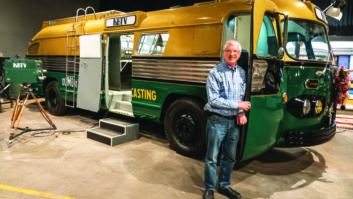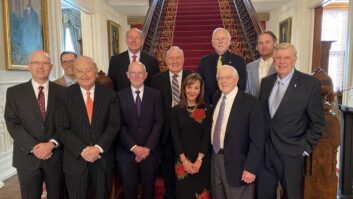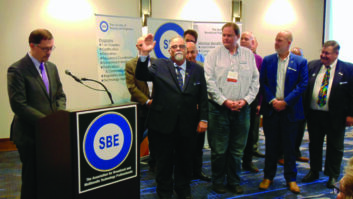A friend of mine once described me as a prodigious collector of electronic manure. That’s probably true.
If you are a lot like me, and I suspect you are or you wouldn’t be reading Radio World, one day you will wake up and ask yourself: “What am I going to do with all this stuff I’ve collected?”
For me, collecting has been a lifelong passion. Even as a kid, I frequented junk shops, radio and TV repair shops and even the town dump to find various electronic treasures. It was a very sad day when my father insisted that I clean out my collection of accumulated stuff before leaving home for college. I suspect he knew that I wouldn’t be returning for any extended period of time and didn’t want to have to deal with my junk if I never returned.

The Telecruiser
Photo by David Temple COLLECTING ADDICTION
The addiction to accumulating old things never disappeared. As I’ve gotten older, I’ve tried to figure out what to do with several decades of accumulation. It’s a bit overwhelming, but for me, the answer seemed to be a museum.
In fact, I already had one but it just wasn’t easily accessible, nor open to the public. It resided in the same building that houses two working radio stations (that’s what I do in my day job), several antique cars and a DuMont Telecruiser TV remote van.
They have been a space-eating passion for most of my life. The problem is, the space was getting quite crowded. What’s more, I had two nearby friends with similar afflictions. One prefers to collect radios and TVs, with several hundred tucked away in various storage lockers. The other has a peculiar affinity for extremely heavy radio transmitters, though he is generally interested in anything old that uses electricity. If it make noise, or produces a picture, that’s all the better.
We all needed some place to put this stuff. As a result, I ended up starting the Texas Museum of Broadcasting & Communications.
Right now, it is a work in progress, located in the downtown area of Kilgore, Texas.
Why Kilgore you ask?

Check out the Ampexes (and other reel-to-reel recorders). Well, I live near there. But it is a nice small town with an interesting history, several other museums either open or underway, a junior college with some 5,000+ students, and most importantly, an available building! It is also bordered by Interstate 20, located about two-thirds of the way between Dallas and Shreveport, La. Did I mention that real estate there is way cheaper than in Dallas, Los Angeles or New York?
So Kilgore it would be.
The idea for the museum came into focus when an eight-year-old Cub Scout visiting my radio station asked me how people got on the internet in an era when they didn’t have smartphones. He really didn’t know. He’s never known life without a cellphone or a tablet in his hand. Somehow he, and his generation, need to know more. A public museum seemed like an ideal way to do it.
I don’t mean to discourage anyone from trying to do something similar in their neck of the woods, but launching this has not been easy. Even though I have had quite a bit of experience in the management of an automobile museum, I’d never attempted to start something like this from scratch. There were quite a few obstacles along the journey, which isn’t over yet. Almost every day, I anticipate some pitfall. It’s the kind of thing that gives you something to think about around 4 a.m.

And here’s part of the old radio collection — from wood and tubes to plastic and transistors. ASSESSING MY OPTIONS
After searching for a suitable building in the area, our choice came down to two: An abandoned TV station a few miles away in Longview, Texas, and a former car dealership in downtown Kilgore.
The TV station had a lot going for it because it still had their old analog equipment inside. The cameras had disappeared, as had any of their new digital equipment, but there was a lot left behind. That would be a plus, and the seller agreed to include everything with the deal. So I started the process of meeting with the various city officials to find out what the city would require. The brief answer would be “a lot.”
It seems when you say the word “museum,” you trigger a lot of expensive requirements. That designation turns a building into a “public gathering place” and gives you the same fire-rating as a theater or auditorium. The code requirements are stringent.
This building was going to require extensive asbestos abatement, a fire sprinkler system and a fire alarm. The city required that the parking lot area be increased, but for the life of me, I don’t know where they expected more parking space to come from.

It also needed a new roof, which would not be cheap on an 18,000-square-foot building, as well as extensive interior restoration because of that leaky roof. It also was going to need a lot of work on its barely-working circa-1984 air conditioning system.
All of these things seemed possible, but expensive.
I eventually talked the seller into a 50 percent reduction in their asking price because of all the work it needed.
Then the city dropped a real bomb shell: In one meeting, they said, “By the way, you will need to install a fire hydrant in front of the building.” That didn’t seem too bad, until they announced, “Oh, there isn’t a water main on that street” — which happens to be the access road to Interstate 20. “You will have install around 600 feet of 12-inch water main at your expense.”
That was a huge deal breaker.

A smattering of the museum’s microphone collection including (left to right) an American Microphone D-33 (used as a prop in Oliver Stone’s “JFK”), American Microphone D9-A (also used as a prop in many movies and commercials), RCA 77-DX, Electro-Voice 630, RCA 74-B “Junior Velocity,” Electro-Voice 654 and a Turner Model 33D. KILGORE
Thankfully, I’d also looked in Kilgore and discovered the building we now own.
It was built in 1949–50 to be a Chevrolet dealership. It is a bit over 19,000 square feet and was in reasonable condition.
It hadn’t been used as a car dealership for many years. In fact, most people thought it was vacant. It wasn’t. A family owned it and used it as playroom and a place to store their collection of cars, a motor home and various and sundry toys that wouldn’t fit in their house.
Through mutual acquaintances, I met with the family to see if they were interested in selling. When I told them what I wanted to do, and with the assurance that we were an established 501(c)(3) not-for-profit, they volunteered to have it appraised and donated over 65 percent of the appraised value in exchange for a tax deduction. We were able to make up the difference with private donations, including some from my pocket.
We finally had a building, which the museum owns free and clear.
But it wasn’t as easy as that sounds.

This seemingly ancient automation and playback equipment looks almost new. Starting on the left in the first rack group, on top of the Schafer 901 automation system are: a Marti remote unit, Raytheon, RCA and General Electric remotes mixers. The next group has, starting at the top, a Magnecord reel-to-reel recorder, a Schafer studio remote control, CBS Audiomax and Volumax processors and a Hewlett-Packard audio oscillator. The third group contains a variety of test equipment built by RCA and General Radio. The fourth group is an RCA BTA-1MX 1000 watt AM trans-mitter. On the far perpendicular right is a General Electric TV audio console and an Autogram console. The city of Kilgore also has code regulations, and we would need to make the building comply with them before we could open to the public. We are still working through that process.
We had the same fire code requirements as anywhere else, which has included installing a very expensive fire sprinkler system that included installing a new 6-inch water main to connect the sprinkler system to. I got the city to cut us a deal on digging up the street, but it still was quite expensive. I would have rather spent the money on some vintage TVs or radios.
We also had to install an elaborate fire alarm system, replace all the exit doors with modern steel fire-rated doors with panic bars, and widen some doorways for better access (it seems we are a lot wider than people of the 1950s). We’ve had to install an external fire escape for the second floor. There were a bunch of minor renovations including installing illuminated exit signs and battery-operated emergency lights, which generate incredible RF interference.
We also had to comply with the Americans with Disabilities Act, which has required us to remodel the existing restrooms and build two additional ADA-compliant restrooms, as well as a series of ramps and easy-to-open doors.
The building needed some basic cosmetic upgrades, including painting. It takes a lot of paint to cover such a large structure.
We have also changed out all of the display lighting to LED. That technology has come a long way recently and isn’t much more costly than using less-efficient quartz lighting. The savings in power consumption and the life expectancy of the lights should pay dividends in the long run.
This seems like a lot of trouble just to house the junk collections of a few eccentric collectors. Perhaps it is, but I think it will be well worth it.
Our mission is to save technology so future generations can see how we got to the present day. Far too much of this kind of stuff seems to head for the landfills or the recycling center.

The former Kilgore, Texas, Chevy dealership, now a broadcast museum.WHAT’S INSIDE
When we are done, we will have a working TV studio where kids can run a camera, do a newscast or be the weather person.
There will be two working radio studios, one a 1960s-era top 40 re-creation using authentic equipment, including turntables, cart machines and reel-to-reel Ampex recorders. Another that will be a 1970s-era talk radio studio which will also be useful for recording radio plays and the like.
There will be an extensive display of broadcast TV cameras and equipment, as well as a large display of radio and TV receivers. Our second floor houses our restoration shop and a library. In what was once the body shop, we have a working wood shop and paint booth for restorations and set building.
Our Great Hall, will be the home of my 1948 DuMont Telecruiser, one of the first black & white TV mobile units ever built. This area will eventually include a stage, with AV and lighting support to make it suitable for various events, parties, lectures or even small concerts. This is one way we will have to generate some income to sustain the facility.
The good news is the city of Kilgore and its residents have really embraced the idea. I think it will become a big asset for the community.
If you are headed to Texas, I hope you will put us on your itinerary. It will be worth the trip. Our grand opening is scheduled for Sept. 16.
Because we don’t have a paid staff, we will only be open limited hours; however if you will call or write ahead, we’d be happy to see you by appointment.
Even if you aren’t able to join us in person, I’d encourage you to become a member. You will get free admission, receive a periodic newsletter, and best of all, become an important part of preserving a little bit of history.
Find us online at www.txmbc.org or on Facebook at www.facebook.com/txmbc.
Chuck Conrad is a longtime east Texas radio vet and, now, chief cog for the Texas Museum of Broadcasting & Communications.







